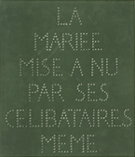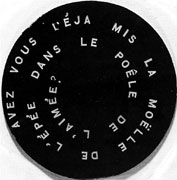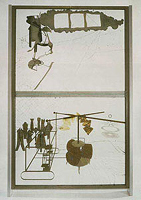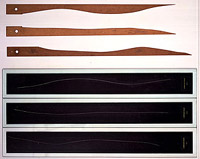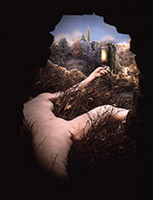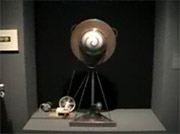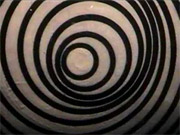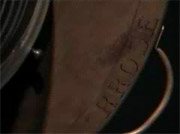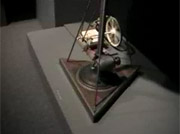|
Precision
Optics / Optical Illusions: by Michael Betancourt
|
|||||||||||||||||||||||||||||||||||||||||||||||||
|
Optical illusions present images which are "true" but inconsistent. The lines which form the pulsating illusion in Duchamp's "precision optics" gain their meaning only from the relationship we choose for them; our internal decision that one orientation is more probable than another results in its apparent shift between these mutually-exclusive spatial positions, and understanding it requires the acceptance of these potentials as being a "probability set." This is why these images are technically inconsistent--they present incompatible versions of themselves. Visual forms of this 'class' offer a liminal experience--one where the process of seeing becomes visible in/through that process itself. The optical illusion is a liminal experience; it allows a visualization of the process of interpretation which is normally unconscious. Vision is rendered regressive by optical illusions. The name 'rotoreliefs' refers to optical illusions which appear as three-dimensional forms when displayed on a rotating surface (Fig. 2) such as a phonograph turntable. Superficially, they present an apparent contradiction to this prohibition against "retinal art."' Once in motion they display a pulsating "relief" that oscillates between positive and negative space. Duchamp used these illusions in Anémic Cinéma (1926) (Fig. 3) alternating them with a series of French puns, each arranged into a spinning spiral:
P. Adams Sitney recognized that sexuality is the subtext to this film, but it is a subtext which requires the interpretation of the viewer looking at the juxtaposition of rotorelief and the text. The meaning produced is an overlay onto the image; this overlay does not resolve the issue of the (potential) retinal nature of these images. The sexuality which Sitney notes is a result of the punning character of the statements; these "word plays" act through a double meaning which becomes apparent when they are read aloud. The doubling of the puns parallels the doubling of the 'rotoreliefs.' The gyrating shapes Sitney describes are the retinal aspect of the 'rotoreliefs.' This effect originates in the inconsistency of human perception which optical illusions exploit. It is the interpretative shift of the "precision optics" which moves the experience of looking from the purely visual into the mental realm:
The invention of new "signs" for an abstract language corresponding to terms in a dictionary without concrete reference divests language of its meaning, allowing its manipulation in purely technical terms. His proposal parallels what Hilbert attempted to do for mathematics. The Bride Stripped Bare by Her Bachelors, Even Duchamp claims is the result of the system which The Green Box documents. The meaning of "abstract" words appears only through their contextual usage. Duchamp suggests what he means by this in his text called *the. While the search for "prime words" and all that entails may be an unrealizable proposal, the new "signs" which become the letters of a "new alphabet" would logically be used to produce a new, formal and abstract language in the same sense that Hilbert's formal system transforms the ordinary language of geometry into a new language. Kurt Gödel demonstrated in 1932 that formal systems such as Hilbert's produce inconsistencies which are inherent to logic:
Gödel's proof is based on a paradox: Theorem G is demonstrable only if it is not demonstrable, but to demonstrate that it is demonstrable is to show that it isn't. The appearance of this infinite regression of logical consequence arises because G is inconsistent; in the formal system of logic, its construction is both correct and invalid at the same moment. The statement is a true statement of logic that cannot be true. The paradox which G'del produces is one that follows the formal rules for the logical system of symbolic mathematics from which the description above is a translation; that system is thus inconsistent:
Viewed by themselves and not as part of the film, the 'rotoreliefs' become optical illusions only when they are in motion. Until that happens, they are circular geometric signs. Understanding them as objects requires considering them as they appear when moving and stationary; in motion, their most evident feature is the illusion of space which they evoke.
The "loss" Duchamp describes implies a transformation of the retinal into a mental construction of the type which optical illusions typically present: they provide two similar objects contained in a single image which defies our ability to easily visualize it.(10)The experience of optical illusions allows us to look at "seeing." In apprehending these illusions we do transfer the memory from one image to the next; that is how we recognize the oscillation between the two positions. In a comment published in 1948, Duchamp echoed his note from The Green Box:
By "look at seeing" Duchamp describes the particular interpretative effect which accompanies optical illusions. The 'rotoreliefs'' visual oscillation only results from spinning the disks. There is a double contrast here: between static image and the motion image, as well as between the two interpretations of the illusion of positive and negative volumes. It is not possible to "see" both volumes at the same time just as it is not possible to experience the illusion while the disk is stationary. The shift from one volume to the other makes the observer aware of the way biological vision gets interpreted into "seeing." The encounter with the "space" which these illusions create is a delayed one--the machine that displays them must first be set in motion. Once that happens, the "space" of the illusion becomes immanent. However, this "space" is unstable as Anémic Cinéma demonstrates and Sitney observes: the illusions pulsate, apparently projecting outwards only to reverse their direction and recede. The volumes which the 'rotoreliefs' create are internally inconsistent--they present two mutually incompatible images at the same time. In looking at these objects, it is the process of interpretation which becomes apparent through the oscillation that Anémic Cinéma connects with sexuality. The oscillations of these optical illusions may be the "cinematic blossoming" produced by the Bride's desire. Duchamp makes this condition apparent in his explanation of each component of the Large Glass:
The appearance of the 'rotoreliefs' in a film called Anémic Cinéma is not coincidental; it is explicitly related to the Large Glass. This note suggests that the "blossoming" cannot be presented in the same manner as the rest of the painting. The action of the pictured machinery will not actually appear within the painting itself. It is suggestive of the 'rotoreliefs,' especially due to their appearance in the film. The pulsating movement of the 'rotoreliefs' visibly resembles "blossoming." That the "whole graphic action" of the Large Glass cannot be expressed by the same techniques as the painting is significant. The work may be technically "unfinishable"; part of its being left "incomplete" may be the depictive problem which is solved by optical illusions such as the 'rotoreliefs.' As with a record, the 'rotoreliefs' have a hole in the center which is registered on a pin centered on the turntable. The mounting of the disk presents a sexual metaphor which is repeated throughout Duchamp's iconography. "Precision optics" presents' an illusion of graphic movement which makes the reliefs appear when playing the disk. This activity is a replay of the action of the chocolate grinder. The static nature of the disk is "consumed" by setting it into motion:
Duchamp explicitly explains the transition from retinal to mental here. The senses the concept of "apparition" suggest: (1) the opposite of its retinal effect. This "sense" would mean that "apparition" is a mental state of perception for an object. (2) That the "apparition" appears discursively through a sequence of terms he sets in context. (Continuing the mathematical parallel, these are undefined terms in a Hilbert-type formalism where meaning appears through specific contextual use rather than a direct definition). The "apparition" is a visual effect that appears mentally through the "chocolate type light." The chocolate object is consumed by the chocolate grinder to produce the illuminating gas for the bride machine.(14) The bride machine then begins moving to produce the "cinematic blossoming"--which is the action of the 'rotoreliefs.' Static imagery transforms into (both) mental and physically activity; the playing of a rotorelief on a phonograph thus recreates the action of the bachelor machine which fuels and makes active the bride. By playing the disk the audience takes the place of the bachelors. The bachelors are the force which sets Duchamp's "mathematics" in motion. Theirs is a specific position in his system, one which repeats in his final work:
Etant Donnés (1945-1966) (Fig. 6) is a large complex optical illusion. The fixed perspective / view places the audience looking through the door not only in the role of voyeur, but shifts the spectator into the role of the bachelors in the Large Glass. This action is repeated by the 'rotoreliefs.' It is important to remember that a phonograph of the type available in the 1920's requires someone to crank the machine to set the disk into motion. The spectator "grinds" the "chocolate object" producing the "chocolate type light" which is the motion of the disk. Without this active participation nothing happens. The apparition of the 'rotoreliefs' is after-the-fact of retinal stimulation: a "delayed" experience where the transfer from visual comprehension to intellectual comprehension is a change in mental state. That the work is an optical illusion reiterates the relationship as a "false" one. It cannot be both flat and dimensional at the same moment. The knowledge that it is flat and the perception of volume are incompatible. "Precision optics" are therefore inconsistent. Thus, perception of the finished piece is separated from its reality through the interpretation. Duchamp's approach incorporates the inconsistency of observation that optical illusions exploit:
The optical component of these works, their "retinalism," is an illusion: they are not physically as they appear, nor is their effect a result of their physical reality. Where the Large Glass both excludes the audience (by incorporating them into some of the potential views), the later work replaces the bachelors with the audience. This shift appears specifically in the 'rotoreliefs.' Within this framework, the film Anémic Cinéma is rendered almost redundant through its literalization of the "cinematic blossoming" the 'rotoreliefs' demonstrate literally through cinema. The "anemia" of the title suggests an awareness of this redundancy by Duchamp and a connection between this awareness and the word "cinema" itself. The title is a near-palindrome, spelled the same forwards as backwards. It presents the problem of "2 similar objects" and allows the function of the puns and word-play of this film as derivable from the system of "prime words." Each pun replays the action of the 'rotoreliefs' linguistically. It is a translation between the everyday language of "undefined terms" and the symbolic order which his formal notational system proposes. The role of "precision optics" is to present these "signs" in the form of new statements. Inconsistency plays a significant role in these works because they base their effect and thus their meaning on the encounter between the audience and the work itself.
The translation
of one set of terms into a statement within a formalized system is
an action of rendering equivalences between one kind of notation and
another. However, this action is only apparent to those who are aware
of both formal systems; the sexual implication of the combination
which Sitney notes, instead of simply being a juxtaposition of "neutral"
content, is a logical combination within the system Duchamp calls
"precision optics." He applied that term to the Rotary Demisphere
(1925)(Fig. 7a, b, c, d) and the 'rotoreliefs'
generally. The "precision" of these works lies in the linkage between
the retinal (optical illusion) and the formal logical system. This
is more than just an iconographic connection; it is the literal
relationship between equivalent terms in a mathematical formalism.
While the retinal effect of the two kinds of presentation in Anémic Cinéma remains markedly different, it is also fundamentally
the same mental sphere. Alternation in the sequence of the
film demonstrates their interchangeability. While Sitney is correct
that "the sexuality is neither in the literal meaning of the words,
nor represented in the optical illusions, seen by themselves," the
formal system Duchamp devised is sexual: his art is representational
within that system: thus sexual.
The appearance of the sexual content is built-in to his conception of "antiretinal." The only group of artists which he believes also took an antiretinal attitude were the Surrealists. Given the sexual content of the mathematics at work in the 'rotoreliefs' and Etant Donnés... it is logical that Duchamp would feel Surrealism was also antiretinal is logical. The function of optical illusions in his later works is predicated on this translation of sexuality into visual forms. This is explicit in his final work. Inconsistency is inherent to this formulation not only because optical illusions exploit inconsistency as their form, but because the initial version of his formalized system presented in the Large Glass places the audience physically outside the system while at the same time including them in it:
Anne d'Harnoncourt's description of the Large Glass presents its inconsistency clearly through the combination of "accessible" and "abstruse." This is a paradox. It cannot be both. That Duchamp's art is paradoxical is self-evident: "we see through them more than we see them." The transparency of the work is also its opacity. The inconsistency inherent to the optical illusion plays itself out intellectually and literally. "Precision optics"--Anémic Cinéma and the 'rotoreliefs'--then, are important elements in the elaboration of Duchamp's inconsistent system of formalized sexuality. There is a component of the rhetorical in Duchamp's claims; for example, the system he claims produced the Three Standard Stoppages has been shown to be false.(19) The precision of the "precision optics" lies in the way that they translate these rhetorical positions and claims into the physical form of the objects themselves. This is the intellectualization Duchamp mentions being a partial component of Surrealism, but which "stopped short" because it does not completely subsume the work into the intellectual framework in the fashion that "precision optics" does.
Notes
Figs.
1~7
|
|||||||||||||||||||||||||||||||||||||||||||||||||
